Six Sigma is a methodology for process improvement that involves minimizing defects and variation. It is originated by Motorola in the year 1980. Since then, it has been widely adopted across industries to achieve excellence in performance.
Companies employing Six Sigma tools and philosophies succeed in producing nearly defect-free products and services, focusing on reducing variability in processes. This systematic approach is primarily based on data and is designed to deliver predictable, high-quality results.
Table of contents
- Understanding the Math Behind Six Sigma
- What is Six Sigma?
- Goal of Six Sigma – Near-Perfection
- 5 Guiding Principles of Lean Six Sigma
- Six Sigma as a Benchmark or Goal
- Key Themes of 6 Sigma
- Metrics and Performance
- Tools and Techniques
- Hidden Truths About Six Sigma
- Methodology
- Six Sigma in Different Industries
- Why Adopt Six Sigma?
- Role of Six Sigma Experts
- Benefits
- Challenges of Implementing Six Sigma
- Impact on Businesses
- Final Words
- Related Articles
Understanding the Math Behind Six Sigma
Six Sigma is mathematically represented as 3.4 defects per million opportunities (DPMO). We can understand this:
- 6 Sigma = 3.4 defects per million
- 5 Sigma = 230 defects per million
- 4 Sigma = 6,210 defects per million
- 3 Sigma = 66,800 defects per million
- 2 Sigma = 308,000 defects per million
- 1 Sigma = 690,000 defects per million
Note: The higher the sigma level, the fewer defects occur
Hence, it indicatesgreater process capability and efficiency. Most organizations operate at around 3 to 4 Sigma. This means there is still significant room for improvement.
What is Six Sigma?
In simple words, Six Sigma is a business strategy and methodology designed to improve the quality and efficiency of processes by reducing defects and minimizing variability. The term is introduced by Bill Smith at Motorola in 1986. It aims to create processes that have a high level of precision, with a goal of achieving 99.99966% defect-free output.
This translates into only 3.4 defects per million opportunities. When companies follow structured approaches and statistical tools, it helps in improving performance, reducing waste, and increasing customer satisfaction.
Historical Background and Business Case
Six Sigma is originated at Motorola in 1979 as a response to declining product quality and financial performance. With the introduction of Six Sigma Motorola revolutionized the way businesses approached quality. They did so by focusing on preventing defects rather than merely detecting them.
By the early 1990s, many Motorola facilities were operating at or near Six Sigma levels. The company’s success led to increased sales productivity and significant cost savings, which is demonstrated in the financial benefits of Six Sigma.
General Electric (GE) is another name in the list that significantly benefited from Six Sigma. Jack Welch, GE’s former CEO, made Six Sigma a mandatory part of the company’s operations in 1995. As a result, GE saw a substantial improvement in profitability, with Six Sigma contributing millions of dollars in savings.
Due to the success stories of companies like Motorola and GE, Six Sigma has become a widely adopted business strategy across various industries. Since then, influence has expanded beyond manufacturing into service sectors such as banking, healthcare, and hospitality.
Companies like American Express, Bank of America, and even retail giants like Home Depot have embraced Six Sigma, recognizing its potential for improving efficiency and reducing costs.
Concept
At its core, Six Sigma focuses on improving the quality of processes in manufacturing and business operations. This is possible by identifying the root causes of defects and removing them, thereby reducing process variability. This leads to more consistent outcomes and higher customer satisfaction.
The Six Sigma philosophy defines, measures, analyzes, improves, and controls every business activity as a process. Moreover, it emphasizes that by treating activities in this systematic way, businesses can consistently drive improvements and maintain quality control.
Hence, the companies can smoothen their operations and reduce inefficiencies. The goal is to ensure that inputs (which are variables in a process) lead to consistent, high-quality outputs. It can be mathematically represented as:
y = f(x)
Where:
- y represents the output.
- x represents the input.
- The function f explains the process that converts input to output.
Key Characteristics
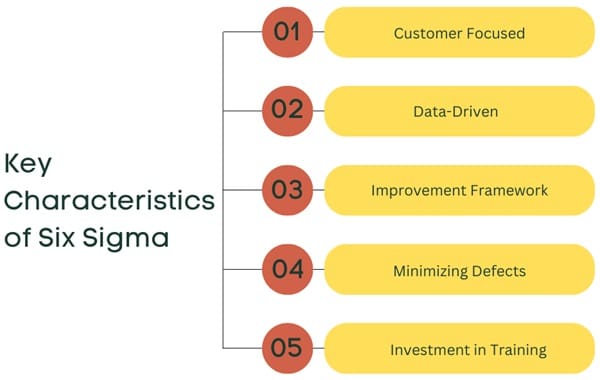
- Customer Focused: It places great emphasis on understanding customer needs and designing processes to meet those requirements efficiently.
- Data-Driven: Six Sigma project decisions are based on data analysis and statistical methods, rather than assumptions or anecdotal evidence. This ensures that improvements are factually rational and measurable.
- Improvement Framework: It operates through structured, methodical steps to improve existing processes. The most well-known framework is the DMAIC model (Define, Measure, Analyze, Improve, Control).
- Minimizing Defects: As a statistical concept, Six Sigma targets process variations and aims to limit defects to 3.4 per million opportunities, which translates to a 99.9997% defect-free rate.
- Investment in Training: Achieving Six Sigma within an organization often requires extensive training. Employees at different levels may earn certifications (such as Yellow, Green, or Black Belts), which give them the skills to lead or participate in improvement projects.
Philosophy
Six Sigma is a philosophy of process performance and improvement. It aims at delivering products and services with near-zero defects by reducing process variation. The primary focus is on:
- Variation Reduction: Identifying and eliminating sources of inconsistency in processes.
- Data-Driven Decisions: Using statistical analysis and metrics to guide decision-making.
- Customer-Centric Approach: Tailoring processes to meet customer needs and expectations consistently.
- Continuous Improvement: Striving for perfection, yet understanding the need for ongoing improvement through experimentation and risk-taking.
Goal of Six Sigma – Near-Perfection
Six Sigma gets its roots from statistics. Specifically, it refers to the target of operating with only 3.4 defects per million opportunities. This itself is an incredibly high standard of quality.
While it may seem unattainable for most organizations, the philosophy behind this goal is to strive for near-perfection in fulfilling customer requirements. The idea is that even if a company cannot fully reach this ideal, striving toward it will result in significant improvements in quality and efficiency.
5 Guiding Principles of Lean Six Sigma
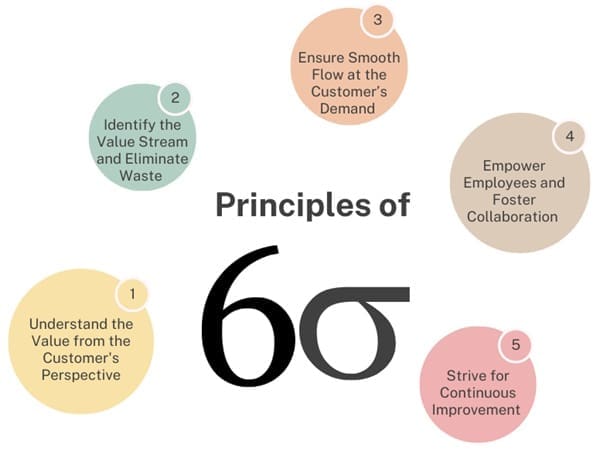
1. Understand the Value from the Customer’s Perspective: The first principle emphasizes looking at your processes from the customer’s viewpoint. To ensure success, a business needs to define what the customer truly values in its products or services.
2. Identify the Value Stream and Eliminate Waste: Once you understand what the customer values, the next step is to analyze the entire value stream—the series of processes that together deliver the product or service. Instead of optimizing individual processes in isolation, businesses should look at how all processes work together to create customer value. In doing so, they can identify waste, inefficiencies, and inconsistencies that reduce performance. Lean Six Sigma targets variations in processes and aims to eliminate steps that don’t add value, such as overproduction, waiting time, and defects.
3. Ensure Smooth Flow at the Customer’s Demand To maximize efficiency, businesses should ensure that their operations flow seamlessly to meet customer demand. This principle encourages organizations to produce only what is needed, when it’s needed, and in the required quantity. Moreover, minimizing bottlenecks and delays ensures a smooth flow of production or service delivery.
4. Empower Employees and Foster Collaboration: Directly involved employees in day-to-day operations typically understand processes and challenges best. By involving them in decision-making and problem-solving, companies empower these employees to drive continuous improvements. Consequently, this approach enables businesses to foster an environment where teams align with organizational goals, openly communicate, and actively implement improvements.
5. Strive for Continuous Improvement: It is rooted in the philosophy of continuous improvement. This principle encourages organizations to never settle but always look for ways to refine and enhance processes. By continuously learning about their operations, businesses can spot new opportunities for improvement, innovate, and strive towards operational perfection. Improvement should be ongoing, with organizations constantly measuring and learning from their experiences.
Six Sigma as a Benchmark or Goal
The benchmark of 6 Sigma is considered an aspirational target for process excellence. It is not just a random number but a well-defined level of capability that leading organizations strive to achieve. For example, achieving Six Sigma in a process like payroll processing or airline baggage handling means there are minimal errors, leading to higher customer satisfaction and efficiency.
Key Themes of 6 Sigma

Six Sigma is built upon several essential themes, including:
- Customer Focus: All improvements should be aligned with customer needs.
- Data and Facts: Decisions are made based on quantitative data rather than assumptions.
- Process-Oriented: Emphasizing that all work is a process and can be mapped, measured, and improved.
- Proactive Management: Encouraging leadership to anticipate problems and drive improvement before issues arise.
- Collaboration Across Boundaries: Promoting teamwork across departments and even with external partners like suppliers.
- Perfection and Risk-Tolerance: Striving for perfection while accepting that mistakes can be learning opportunities.
Metrics and Performance
In 6 Sigma, the term sigma refers to a statistical measure of variation from the mean in a normal distribution. In business terms, the goal is to achieve Six Sigma quality, which means having only 3.4 defects per million opportunities. This is a high level of performance that requires a well-controlled and consistent process.
Here’s a practical breakdown of Six Sigma quality levels:
- At 3 Sigma (which is roughly 93.32% accuracy), there would be thousands of errors or defects per million opportunities.
- At 6 Sigma, the rate of defects drops to just 3.4 per million opportunities, representing near perfection.
For example, achieving Six Sigma in the context of mail delivery would mean losing only 7 letters per hour, compared to over 20,000 lost letters per hour at a lower sigma level.
Tools and Techniques
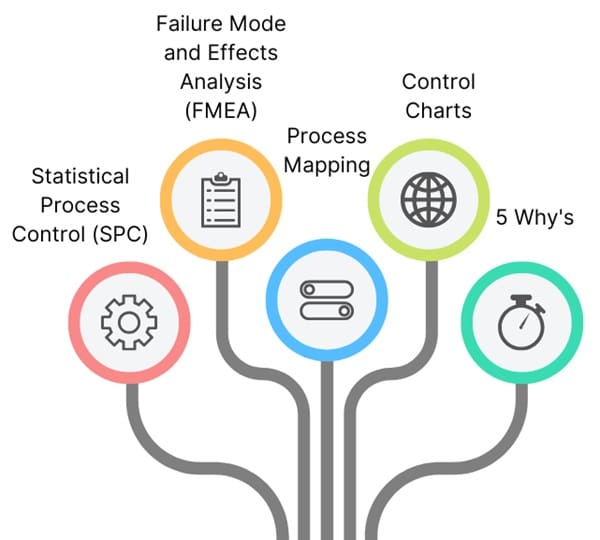
A variety of qualitative and quantitative tools are employed within the Six Sigma methodology. These tools help in analyzing, improving, and controlling processes:
- Statistical Process Control (SPC): This tool monitors and controls process performance. By plotting data points on control charts, organizations can determine whether the process is stable and identify any points where performance deviates from expectations.
- Failure Mode and Effects Analysis (FMEA): This proactive tool identifies potential failure points in a process. Teams can prioritise improvements by assessing the likelihood of different types of failures and their potential impact.
- Process Mapping: Visual representations of a process help teams understand how different steps are connected. This is especially helpful for identifying inefficiencies or bottlenecks in workflows.
- Control Charts: Control charts track performance over time and help identify whether a process is in control. These charts can highlight unusual variations that might indicate potential problems or opportunities for improvement.
- 5 Why’s: A root cause analysis technique that involves asking “why” repeatedly to uncover the fundamental cause of a problem. This technique is effective in identifying the real underlying issues.
Hidden Truths About Six Sigma
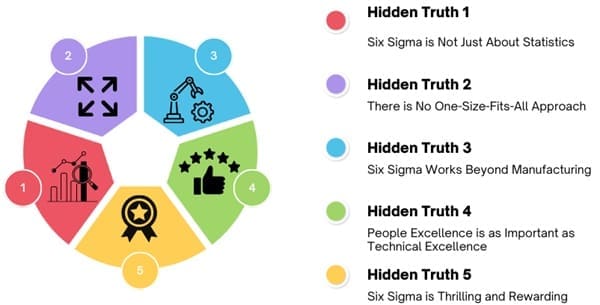
While Six Sigma is widely regarded as an effective methodology, there are some hidden truths about it that are often overlooked. Understanding these truths can help organizations unlock even greater potential from Six Sigma.
Hidden Truth 1: Six Sigma is Not Just About Statistics
Though Six Sigma employs a variety of statistical tools, it’s not solely a technical method. It incorporates a wide range of business best practices that contribute to its success. For instance, Six Sigma can be applied to strategic planning, operations, and customer service, enabling businesses to maximize their efforts in multiple areas.
Hidden Truth 2: There is No One-Size-Fits-All Approach
One of the strengths of Six Sigma is its flexibility. Different organizations can customize their Six Sigma approach to fit their unique needs, challenges, and business environments. Trying to copy another company’s Six Sigma implementation is unlikely to succeed, as every business has its priorities and readiness for change. Instead, companies should tailor their Six Sigma efforts to achieve maximum impact.
Hidden Truth 3: Six Sigma Works Beyond Manufacturing
Although Six Sigma originated in manufacturing, its principles can be applied in non-manufacturing settings as well. In fact, service industries, finance, logistics, IT, and other areas have found that Six Sigma can drive significant improvements. Many non-manufacturing activities operate at only 70% efficiency, making them prime targets for Six Sigma initiatives.
Hidden Truth 4: People Excellence is as Important as Technical Excellence
It isn’t just about process improvements and statistical analysis—it also emphasizes people excellence. Creative problem-solving, collaboration, and communication are key to a successful Six Sigma implementation. When employees are motivated and engaged, they can achieve remarkable results. This focus on people can make Six Sigma a powerful tool for driving not just technical improvements but also cultural transformation.
Hidden Truth 5: Six Sigma is Thrilling and Rewarding
Though implementing Six Sigma requires time, effort, and investment, the rewards can be immense. Beyond financial gains, companies often experience intangible benefits, such as increased employee morale, greater enthusiasm, and a more positive work environment. Employees who participate in Six Sigma projects gain confidence and new skills, which can have a lasting impact on both their personal development and the company’s success.
Methodology
At its core, Six Sigma is a data-driven approach that seeks to optimize process performance. The goal is to reach a level of operational efficiency where processes yield a 99.99966% success rate. While many companies historically operated at around a 3.8 Sigma level (or 99% efficiency), the journey toward Six Sigma represents a push for near-perfect operations.
Businesses operating below 4 Sigma often struggle with inefficiencies such as frequent defects, reliance on inspection and rework, and a lack of collaboration across functional areas. To break through this performance barrier, companies must adopt a culture of continuous improvement, driven by data and focused on achieving high levels of process knowledge.
To achieve Six Sigma performance, businesses must challenge the status quo and invest in skilled personnel trained to use the methodology. These individuals, known as “Black Belts” and “Green Belts,” play a crucial role in leading process improvement projects.
Supported by additional roles such as “Master Black Belts” and “Champions,” these experts work in teams to apply the Six Sigma framework and statistical tools to identify and eliminate the root causes of defects.
Key Components of Six Sigma
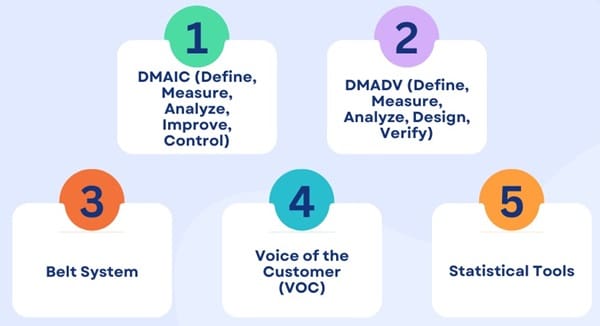
To understand Six Sigma more fully, it’s important to break down some of its key components. These include:
- DMAIC (Define, Measure, Analyze, Improve, Control): This is the core framework used in Six Sigma for problem-solving and process improvement. It helps teams define problems, measure current performance, analyze the root causes, implement improvements, and control future performance to ensure continued success.
- DMADV (Define, Measure, Analyze, Design, Verify): This methodology is used when a company is creating a new process or product. It focuses on designing processes and products to meet customer expectations right from the start.
- Belt System: Six Sigma uses a belt system similar to martial arts to signify expertise levels. Yellow Belts have a basic understanding, Green Belts are trained in more advanced techniques, and Black Belts are experts who lead complex projects.
- Voice of the Customer (VOC): Six Sigma places a strong emphasis on understanding and meeting customer needs. VOC refers to the process of capturing customer feedback and using it to guide improvements.
- Statistical Tools: Six Sigma employs various statistical tools to analyze data, including process capacapability analysis, control charts, hypothesis testing, and regression analysis.
DMAIC Process
A key feature of Six Sigma is its structured problem-solving approach, known as DMAIC, which stands for Define, Measure, Analyze, Improve, and Control. This cycle helps teams systematically approach process improvement. Here’s a closer look at each phase:
Define:
In the first step, you identify the goals of the improvement activity. Here, you clarify the scope of the problem and define what the customer needs. Understanding the problem clearly is essential for driving meaningful improvements.
Measure:
Next, you collect data on the current process. This data helps quantify the extent of the problem and establishes a baseline for comparison once improvements are made. Ensuring accurate measurement systems is vital for reliable data collection.
Analyze:
In this step, you scrutinize the collected data to identify the root causes of the problem. By analyzing the gap between current performance and desired goals, you can pinpoint where improvements are necessary.
Improve:
After identifying the problem areas, you develop and implement solutions. These solutions aim to eliminate the root causes of defects and enhance overall process capability.
Control:
Finally, you focus on maintaining the improvements achieved. You put control systems in place to ensure the process doesn’t revert to its previous state and conduct regular monitoring to ensure continued performance.
Six Sigma in Different Industries
Six Sigma began in manufacturing but has since been applied in various sectors, including:
- Manufacturing: Improving product quality and reducing waste.
- Service Industry: Enhancing customer satisfaction and reducing service errors.
- Healthcare: Reducing medical errors and streamlining patient care processes.
- Finance: Improving transaction accuracy and efficiency in processes like payroll and wire transfers.
Each industry uses Six Sigma to address its specific challenges, but the underlying principles remain the same: reduce defects, improve processes, and focus on the customer.
Why Adopt Six Sigma?
The widespread adoption of Six Sigma is due to its proven results. Organizations that implement Six Sigma can expect:
- Increased Value: Higher quality products and services lead to more satisfied customers and greater shareholder value.
- Reduced Defects: By focusing on defect reduction, Six Sigma helps companies minimize errors and waste.
- Competitive Advantage: A company that can deliver nearly defect-free products gains a significant edge over competitors.
For instance, Motorola reported saving $11 billion over ten years due to Six Sigma initiatives, while AlliedSignal (now Honeywell) estimated savings of $1.5 billion.
Role of Six Sigma Experts
A small, specialized group of trained professionals known as Six Sigma Black Belts largely drives Six Sigma success. These experts undergo rigorous training and are proficient in applying Six Sigma techniques to complex problems. There are also different levels of certification, including:
- Green Belt: These professionals support improvement projects and often work part-time on Six Sigma initiatives. They focus on applying Six Sigma principles to smaller projects within their department.
- Black Belt: Black Belts are full-time Six Sigma practitioners who lead project teams. They have deep knowledge of Six Sigma tools and methods and are responsible for driving process improvements across the organization.
- Master Black Belt: The highest certification level, Master Black Belts serve as mentors to other Six Sigma professionals. They work with executive leadership to ensure Six Sigma strategies are aligned with business goals.
Benefits
Implementing Six Sigma can bring a range of benefits to organizations, including:
- Increased Customer Satisfaction: By improving process quality, organizations can deliver better products and services, which leads to happier customers.
- Cost Reduction: Identifying and eliminating inefficiencies helps reduce waste and lower operational costs.
- Higher Productivity: Streamlined processes are more efficient, allowing organizations to achieve more with fewer resources.
- Employee Engagement: It encourages teamwork and problem-solving, which can increase employee morale and engagement.
- Data-Driven Decisions: By relying on quantitative data, Six Sigma ensures that decisions are based on facts, not assumptions, leading to more effective solutions.
Challenges of Implementing Six Sigma
Implementing Six Sigma is not without challenges:
- Training Requirements: A significant investment in training is needed for employees at all levels.
- Resource Constraints: Organizations often struggle with having enough resources to handle multiple projects simultaneously.
- Managing Expectations: The payoff from Six Sigma projects may take 9 to 12 months to materialize, requiring patience and long-term commitment.
Despite these challenges, it remains one of the most robust methodologies for improving organizational performance.
Impact on Businesses
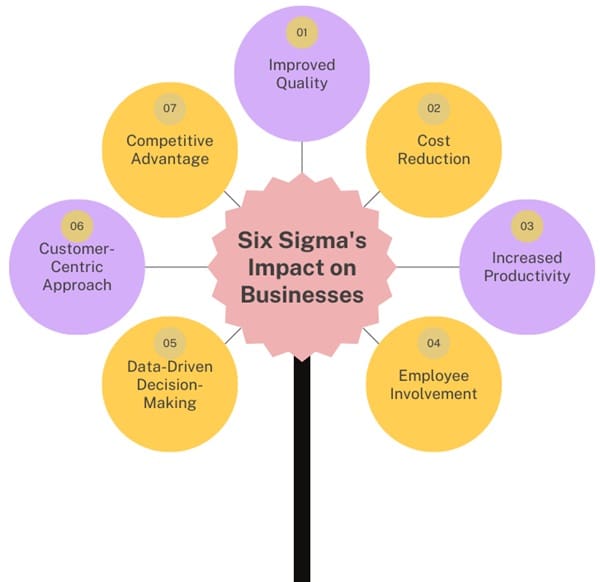
The adoption of Six Sigma offers numerous advantages for businesses looking to improve quality, efficiency, and customer satisfaction. Here’s a closer look at some of the key benefits:
- Improved Quality: By reducing defects and variability, businesses can provide more consistent, high-quality products and services. This leads to enhanced customer satisfaction and loyalty.
- Cost Reduction: One of the main goals of Six Sigma is to eliminate waste. By improving processes, businesses can reduce wasteful activities, minimize errors, and avoid unnecessary expenses, ultimately saving money.
- Increased Productivity: With streamlined and efficient processes, businesses can increase productivity without sacrificing quality. This improved efficiency often leads to better use of resources, shorter production times, and quicker delivery of services.
- Employee Involvement: It involve employees at all levels in the improvement process. This promotes collaboration, fosters innovation, and encourages a culture of continuous improvement across the organization.
- Data-Driven Decision-Making: It relies on rigorous data analysis, allowing businesses to make informed decisions based on facts rather than assumptions. This results in more effective solutions and improved outcomes.
- Customer-Centric Approach: Because Six Sigma places a strong emphasis on understanding and meeting customer needs, businesses can better align their operations with customer expectations. This not only enhances customer satisfaction but also increases competitiveness.
- Competitive Advantage: Organizations that successfully implement Six Sigma often achieve a higher level of operational excellence. This gives them a competitive edge in their industry, allowing them to outperform rivals in terms of quality, cost, and efficiency.
Final Words
Six Sigma offers substantial rewards for organizations willing to invest in it. By reducing variation and defects, companies can increase their reliability and deliver consistent, high-quality products and services. The methodology not only improves financial performance but also fosters a culture of continuous improvement and data-driven decision-making.
The long-term benefits of adopting Six Sigma include significant cost savings, improved customer satisfaction, and a stronger competitive position. Companies like Motorola and General Electric demonstrate that when organizations properly integrate it into their operations, they can achieve enormous potential gains.
Thus, it is more than just a set of tools—it’s a philosophy and a strategy for achieving operational excellence and ensuring long-term success in an increasingly competitive marketplace.

About Six Sigma Development Solutions, Inc.
Six Sigma Development Solutions, Inc. offers onsite, public, and virtual Lean Six Sigma certification training. We are an Accredited Training Organization by the IASSC (International Association of Six Sigma Certification). We offer Lean Six Sigma Green Belt, Black Belt, and Yellow Belt, as well as LEAN certifications.
Book a Call and Let us know how we can help meet your training needs.




















I have some of the Six Sigma tools on my job
I LOVED THIS COURSE SO MUCH. BOOSETED MY MONIES BY $1000k